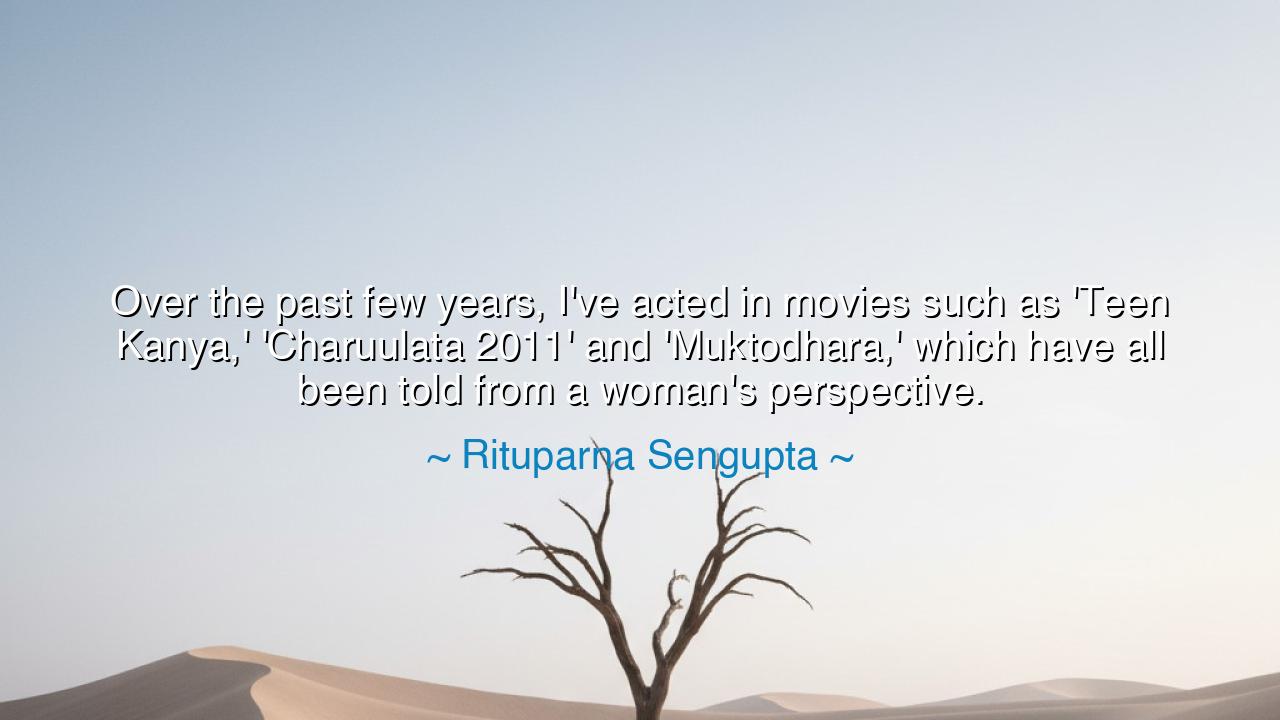
Over the past few years, I've acted in movies such as 'Teen
Over the past few years, I've acted in movies such as 'Teen Kanya,' 'Charuulata 2011' and 'Muktodhara,' which have all been told from a woman's perspective.






When Rituparna Sengupta, luminous star of Indian cinema, declared, “Over the past few years, I've acted in movies such as Teen Kanya, Charuulata 2011 and Muktodhara, which have all been told from a woman's perspective,” she spoke with the quiet power of one who recognizes the weight of her craft. Her words are not merely a list of films, but a testament to the woman’s voice in art, to stories long hidden or silenced, and to the noble work of giving them light upon the screen. Through her reflection, we hear not only the story of her career, but of generations of women striving to be heard.
The meaning of her statement lies in the sacred power of perspective. For centuries, tales were told from the eyes of men, with women as shadows—objects of desire, symbols of purity, or silent sufferers. But Sengupta names her roles as a turning of the tide: each film she chose, whether Teen Kanya, Charuulata 2011, or Muktodhara, placed the woman’s experience at the center. In doing so, she affirms that cinema is not merely entertainment—it is a mirror of society, and the image in that mirror must reflect all voices, not just half of humanity.
Consider the origin of Teen Kanya, based on the tales of Rabindranath Tagore. Tagore himself, though a man of his age, often gave prominence to the inner world of women in his stories. Sengupta, by stepping into such roles, becomes part of a lineage that stretches back to the poet, giving voice again to heroines who embody love, loss, strength, and resilience. In this way, the woman’s perspective is not newly invented, but rediscovered and re-empowered through her work.
History offers another mirror: the rise of female authors in the nineteenth century. Writers like Jane Austen, the Brontë sisters, and George Eliot defied the conventions of their time to tell stories from the woman’s gaze. They shifted the axis of literature, proving that women were not merely muses but creators, not merely subjects but narrators of their own destiny. Sengupta’s embrace of women-centered films belongs to this same heroic tradition—the reclaiming of narrative power by those who had long been denied it.
And yet, her words are also profoundly personal. By saying “I’ve acted,” Sengupta reminds us that this work of giving life to women’s voices is not abstract—it is embodied in her own labor, her craft, her art. To carry these stories requires not only talent, but courage. For to step into roles that challenge stereotypes, that reveal uncomfortable truths, is to stand against the tide of expectation. Her journey, like that of the women she portrays, is a struggle for authenticity against forces that would prefer silence.
O seekers of wisdom, the lesson here is clear: the stories we tell shape the world we live in. If women’s voices are absent, then half the truth of humanity is missing. To support, to honor, and to amplify these voices is not merely a gift to women, but to all people—for only in wholeness can art, and life, be true. Sengupta’s work is thus not just performance, but service: service to truth, to justice, and to the dignity of perspective.
Therefore, let Rituparna Sengupta’s words echo within you: “These films have all been told from a woman’s perspective.” Do not take them lightly, for they carry a mandate. Seek out the unheard voices in your own life—whether of women, the marginalized, the forgotten—and listen with reverence. Tell their stories, or create space for them to be told. For the measure of a society is not in the power of its loudest voices, but in the care it takes for those who have too often been silenced. And in this work, like Sengupta, you too may become a vessel for truth.






AAdministratorAdministrator
Welcome, honored guests. Please leave a comment, we will respond soon